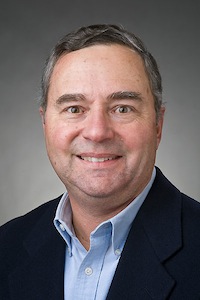New biofuel conversion process cuts costly separating step
Using a biomass-derived solvent, University of Wisconsin–Madison chemical and biological engineers have streamlined the process for converting lignocellulosic biomass into high-demand chemicals or energy-dense liquid transportation fuel.

Dumesic
Their new method eliminates the need for costly pretreatment steps that separate hemicellulose and cellulose, two main components of plant biomass that react at different rates. Pretreatment and extraction or separation steps can account for up to 30 percent of the total capital cost of a biofuels production plant.
James Dumesic, the Steenbock Professor and Michel Boudart Professor of chemical and biological engineering at UW–Madison, and members of his research group described the process in a paper published online Nov. 1 in the journal “Energy & Environmental Science.”
The “magic potion” that enables the researchers to simultaneously process hemicellulose and cellulose, which have significantly different physical and chemical properties, is gamma-valerolactone, or GVL.
Essentially, the team is exploiting the power of GVL to produce GVL, which has potential as an inexpensive, yet energy-dense, “drop-in” biofuel.
For biomass conversion, it’s also an ideal solvent because it already is a product of the conversion process. “You’d make the solvent as part of the process,” says Dumesic. “Water is used now, but it leads to low rates and low yields of desired products.”
GVL broadens the optimal conditions for separately processing hemicellulose and cellulose. As a result, those optimal conditions overlap, enabling Dumesic and his group to process both — with high yields — under the same conditions.
Now, in a single reactor, the researchers can convert hemicellulose to furfural and cellulose to levulinic acid.
In the United States, approximately 300,000 tons of furfural each year are used as solvents and in adhesives and polymers. In their process, the researchers can separate the furfural through distillation during the reaction or, through a series of steps, they can convert furfural to levulinic acid — a desirable value-added biochemical used to make solvents and fuel additives.
Levulinic acid can be upgraded to other platform molecules, including GVL. In fact, in 2010, Dumesic and his group developed a highly efficient two-step catalytic process for converting levulinic acid to GVL, and ultimately, into high-energy liquid transportation fuel. “So, instead of having furfural from the hemicellulose and levulinic acid from the cellulose, you can convert everything to levulinic acid — and that’s easy to convert to GVL,” he says.
In general, says Dumesic, levulinic acid, furfural and GVL are all valuable chemicals that have different applications. “And within the bioenergy space, there’s been more interest recently in making commodity chemicals,” he says. “But if you want to make a fuel, GVL is the way to go, because it can be blended as a fuel additive.”
In addition to broadening biomass processing conditions, GVL also requires far less sulfuric acid than water and it solubilizes lignins and humins — biomass material that typically clogs the system. As a result, those degradation products move freely through and out of the reactor in a more environmentally friendly process. “With GVL, you use 10 times less acid, so you have a more economical way to deal with the waste,” says Dumesic.
And, GVL can mix with water, meaning the researchers’ process works even with biomass that’s wet.
While the group conducted its research in small batches in the laboratory, Dumesic says the process could scale to a continuous-flow reactor. For now, the researchers are studying how long they can use GVL in the biomass conversion process before they have to clean it to remove any impurities that have accumulated in it.
Other authors on the paper include UW–Madison chemical and biological engineering postdoctoral researchers David Martin Alonso and Stephanie Wettstein and graduate students Elif Gurbuz and Max Mellmer. The group received funding for the research from the Great Lakes Bioenergy Research Center at UW–Madison and from the U. S. Defense Advanced Research Projects Agency.
Tags: energy, engineering, research




